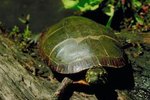
Though everything about them looks somewhat awkward, turtles are interesting animals to observe in the wild or in captivity. In either case, it is important to understand that some turtles are active by day and others are active at night -- termed diurnal and nocturnal, respectively. Few generalizations can be made regarding form and activity patterns; however, related species often have similar habits.
Tortoises and Primarily Terrestrial Species
Most true tortoises are diurnal and will spend their days eating, mating and foraging and their nights hidden in vegetation or in a deep burrow. Pancake tortoises (Malacochersus tornieri) protect themselves by wedging their flat bodies into tight rock crevices. Though Asian turtles of the genus Cuora are called box turtles and feature a hinged shell, they are not closely related to North American box turtles (Terrapene sp.). North American box turtles are semi-aquatic leaning towards terrestrial and are almost exclusively diurnal, while the Asian box turtles are primarily nocturnal. In further contrast to the North American variety, Asian box turtles are semi-aquatic and swim well.
Aquatic Basking Species
Most basking species -- including red-eared sliders (Trachemys scripta elegans), painted turtles (Chrysemys picta), cooters (Pseudemys sp.) and map turtles (Graptemys sp.) -- are diurnal. During the day, these turtles hunt for food, find mates and bask on exposed rocks and logs. Sleeping behavior among these turtles is highly individualistic and different members of the same species may choose to sleep underwater or on an exposed rock, log or sandy beach.
Bottom Dwellers
Mud (Kinosternon sp.) and musk (Sternotherus odoratus) turtles can be active by day, but are most active after dark. Visitors to calm, shallow ponds can often observe the small turtles foraging on the bottom at night. Common (Chelydra serpentina) and alligator (Macrochelys temminckii) snapping turtles are primarily nocturnal, though they may be seen swimming near the surface occasionally during the day. Neither species likes to leave the water, so when females must lay eggs, they do so under the cover of darkness. Much like the snapping turtles ecologically, the mata mata turtles (Chelus fimbriatus) from South America are also largely nocturnal.
Sea Turtles
Sea turtles are primarily diurnal, spending their nights floating near the surface or tucked into a rock or coral crevice. Juveniles primarily sleep on the surface, and have been observed resting with their front flippers folded back over their shell. One exception to this is egg-laying behavior; female sea turtles will come ashore -- generally at night -- to dig a hole in the sand where they will deposit their eggs. Some species of sea turtle hatch at night, and are thought to navigate by moving towards the brightest horizon.
References
- Savannah River Ecology Laboratory: Musk Turtle (Sternotherus Odoratus)
- The Sea Turtle Conservancy: General Behavior Patterns of Sea Turtles
- The Natural Source: Snapping Turtle (Chelydra Serpentina)
- Animal Diversity Web: Macrochelys Temminickii
- Animal Diversity Web: Chelus Fibriatus
- Arkive: South Asian Box Turtle (Cuora Amboinensis)
- Austin's Turtle Page: Northern Map Turtle
- Herps of Texas: Cooter
- California Turtle and Tortoise Club: Pancake Tortoise (Malacochersus Tornieri)
Photo Credits
-
Tom Brakefield/Stockbyte/Getty Images



